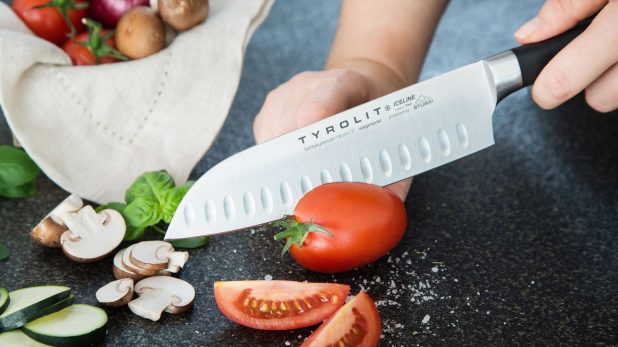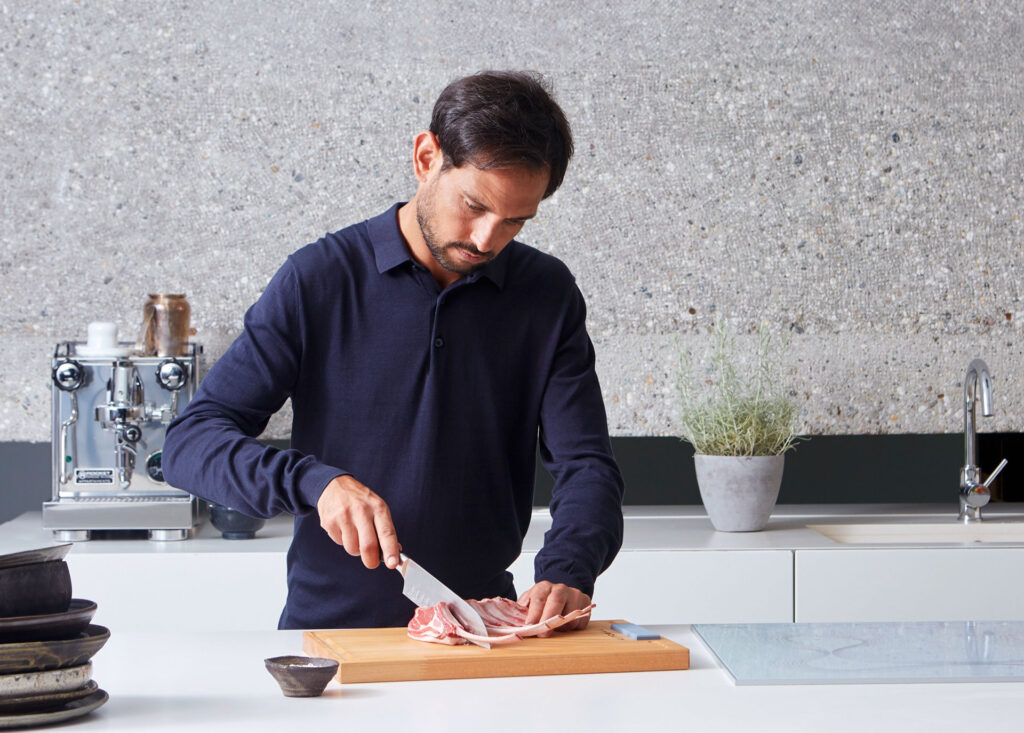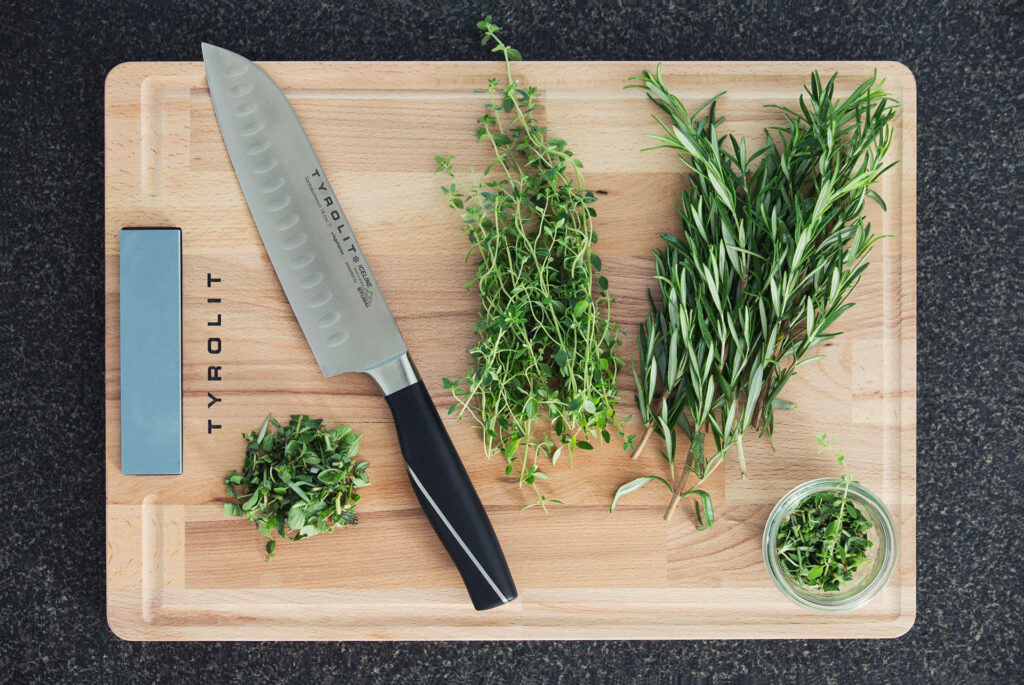Cut correctly with a Santoku knife – that’s how it’s done!

The Santoku knife – an all-purpose knife derived from Japanese tradition – has firmly established its place in modern kitchens. Its distinctive shape not only makes it visually outstanding but also excels in slicing through a variety of ingredients. But how do you properly cut with a Santoku knife?
In this article, we will explore the versatility of the santoku knife, from its characteristic features to the proper cutting techniques that become possible as a result. Whether you’re an experienced chef or an avid amateur chef, here’s everything you need to know about the Santoku knife to achieve optimal cutting results in your kitchen.
What is a santoku knife?
But what is a santoku knife? Originally from Japan, it enjoys great popularity with many chefs. The term “Santoku” is made up of the Japanese words “San” (three) and “Toku” (virtue or tasks), indicating the three main tasks the knife can handle: cutting meat, fish, and vegetables.1
The Santoku knife is characterized by a wide, straight blade with a slightly rounded tip. Compared to other kitchen knives, the blade is shorter, allowing for more precise control during fine cutting.
What can you cut with the santoku knife?
The Santoku knife enables you to effortlessly cut a wide range of foods. Its sharp blade and special hollow edge make it particularly well-suited for slicing meat, fish, and vegetables.
The wide and short blade makes it perfect for precise cuts, simplifying tasks like chopping, dicing, and slicing. The scalloped edge, as seen on the Tyrolit Life Santoku knife, minimizes the sticking of food to the blade, enhancing efficiency and speed in the kitchen. Therefore, the Santoku knife is a versatile tool valued by both professional chefs and home cooks alike.
Cutting techniques with the Santoku
The Santoku knife supports various cutting techniques, turning it into a versatile kitchen tool. Here are some techniques you can employ with the Santoku – but first, a few words on the correct way to hold your fingers.
Safety First – With the Correct Finger Technique
When cutting with the Santoku knife, it is crucial to apply the correct technique to ensure both precision and safety. A fundamental technique involves the so-called claw grip, which is particularly employed during the rocking cut.
For the claw grip, curl your fingertips and hold the food to be cut with your fingertips. Your knuckles should be slightly extended outward. This protects your fingers from injuries while your knuckles assist in guiding the knife.
When using the Santoku knife, glide the blade through the food with a gentle, pulling motion. Ensure not to apply excessive force, but rather let the blade work with minimal pressure.
The Rocking Cut
The rocking cut is a specific cutting technique that is particularly effective when using the Santoku knife – especially if the blade is slightly curved and not completely straight.
In this technique, the blade of the santoku knife is guided in a rocking motion over the food to be cut. The rocking cut allows for an even and precise chopping of herbs, vegetables, or other fine ingredients.
To properly execute the rocking cut, place the tip of the blade on the cutting board and then move the blade in a back-and-forth motion. The tip of the blade stays on the cutting board, serving as a pivot point for the rocking motion. This method enables you to finely and evenly chop food, with the wide blade of the Santoku knife efficiently slicing through the food.
The rocking cut is particularly suitable for preparing herbs, vegetables, or other ingredients that require fine chopping.
Chopping with the Santoku Knife
When chopping with a santoku knife, Japanese and European models face different challenges and bring individual strengths.
Japanese Santoku knives are primarily designed for precise cuts and fine shredding. Due to their special blade shape and extreme sharpness, they are particularly suitable for precise cutting of vegetables, meat and fish. However, they are less suitable for coarser chopping of, for example, nuts or herbs.
European Santoku knives, on the other hand, feature a more robustly constructed blade, making them better suited for tasks such as chopping harder foods. Their design facilitates a more forceful application, which is especially advantageous for coarse chopping techniques.
Prerequisites for a successful cut with the Santoku
To achieve optimal results when cutting with a santoku knife, certain prerequisites and techniques are crucial. The choice of cutting surface and the maintenance of the sharp santoku blade are particularly important.
The Right Cutting Surface
When cutting food, it also depends on the right base. This should be stable, non-slip and at the same time gentle on the knife blade. Cutting boards made of wood or plastic are the optimal choice to ensure the longevity of the knives and to increase safety during cutting.
Tyrolit Life offers cutting boards with integrated grinding stone for the highest demands on quality and functionality. The high-quality beech wood is not only gentle on the blades, but also robust and hygienic. Thanks to the integrated sharpening stone, you can sharpen your knife directly during cutting, which ensures a continuously sharp blade.
Sharp Santoku blade for precise work
Already when buying a santoku knife, value should be placed on high-quality workmanship in order to purchase a durable companion for different cooking tasks. The Tyrolit Life Santoku knife offers outstanding advantages: Made with the highest precision from stainless steel, it convinces with an ergonomic design and a robust blade. The specially developed sharpening angle of 15 degrees ensures optimum sharpness and cutting precision, making it an indispensable tool for every cook.
Nevertheless, as with any knife, it is always necessary to sharpen the Santoku knife periodically. This is where Tyrolit’s grinding expertise comes into play, as they have been intensively involved in the field of grinding and cutting for over 100 years. The Tyrolit Life knife sharpener offers an effective and user-friendly solution for sharpening your kitchen knives. With precise sharpening stones and a pre-set sharpening angle of 15 degrees, the Tyrolit knife sharpener enables effortless maintenance of the Santoku blade. This not only ensures sharp blades but also enhances safety and efficiency in food preparation.
There are also special accessories for safe and gentle storage of the santoku knife. In the Tyrolit Life range, there is a striking knife block that also makes a difference visually. Made from local oak, the knife block provides a secure grip for the santoku knife. The magnetic fixation ensures that the blade is stored firmly and gently, while the integrated knife sharpener facilitates regular care.
The use of a high-quality santoku knife, coupled with regular sharpening and safe storage, forms the basis for a first-class culinary experience in the kitchen. With its innovative solutions, Tyrolit Life offers the opportunity to perfect the art of cooking with a sharp and precise santoku knife.
Chef’s knife, European or Japanese santoku knife?
Whether classic chef’s knife, Japanese or European santoku knife – each of these knife types has specific characteristics that influence the individual cooking style and preferences. The Santoku knife has advantages and disadvantages that you should be aware of. Here is a comparison of these types:
| Chef’s knife | European Santoku Knife | Japanese Santoku Knife | |
| Origin of the tradition | European cuisine | adopted from Japanese cuisine | Japanese cuisine |
| Blade length | long (typically 20 – 25 cm) | varies (usually 16 – 20 cm) | short (typically 15 – 18 cm) |
| Blade Width | narrow | wide | wide |
| Blade Thickness | thick | thick | thin |
| Grinding Angle | approx. 15° | approx. 15° | 10 – 15 ° |
| Focus | Stability | Stability, precision | Precision |
Are you more interested in Japanese knife art? Read more in the article: What exactly are Japanese knives?
FAQs on Proper Cutting with a Santoku Knife
What is special about a santoku knife?
How do you sharpen a Santoku knife?
What is the best way to cut with the santoku knife?
For what cutting tasks is the Santoku knife suitable?
Sources
1 https://www.wortbedeutung.info/Santokumesser/



